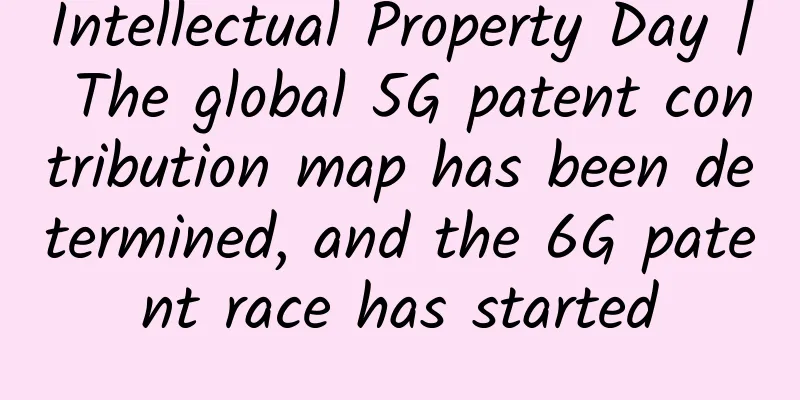Intellectual Property Day | The global 5G patent contribution map has been determined, and the 6G patent race has started

|
"Knowledge is power." Intellectual property is the exclusive right to the intellectual labor achievements created by human beings in social practice. With the development of science and technology, the intellectual property system has emerged and is constantly improving. In the field of advanced technology, the establishment of intellectual property will affect the future market competition pattern. 5G and 6G have been the focus of competition in the field of intellectual property rights in the past two years. The ownership of standard essential patents under the current 5G standard architecture has been basically determined. According to the evolutionary model of "commercial generation, planning generation" of mobile communications, the world has begun research on 6G standards. The 5G patent contribution map has been determined, and the 6G patent race has started. my country's position on intellectual property protection is becoming increasingly firm.
Which company has the best 5G patents?The current 5G technical standards have released two versions, R15 and R16. The 5G triangle architecture (eMBB, URLLC, mMTC) proposed by the International Telecommunication Union (ITU) has been firmly established, and the ownership of standard essential patents under the 5G standard architecture has been basically determined. In order to identify 5G patents, the internationally renowned patent data company IPlytics platform integrates all patents announced by the European Telecommunications Standards Institute (ETSI) and matches these patents with the 3GPP standard database. In March 2021, IPLytics released the "Leaders in the 5G Patent Race" report. As of February 2021, Huawei ranked first with 15.39% of applications, Qualcomm ranked second with 11.24%, ZTE ranked third with 9.81%, Samsung ranked fourth with 9.67%, Nokia ranked fifth with 9.01%, and Ericsson ranked seventh with 4.35%. OPPO ranked ninth with 3.47%, and Datang Mobile ranked tenth with 3.44%. In addition, Apple ranked eleventh with a share of 3.21%, Xiaomi ranked thirteenth with a share of 2.77%, vivo ranked fifteenth with a share of 2.23%, Lenovo ranked seventeenth with a share of 0.9%, and MediaTek ranked twenty-first with a share of 0.70%. In addition to the analysis of declared patent data, the IPlytics platform also collects information on standard-setting companies that actively participate in the development of 5G standards. 5G standards are set at international 3GPP meetings, where companies attend and submit technical contributions, and all members then discuss and vote on the standard. Using the 3GPP standard contribution database of the IPlytics platform, Table 2 shows the contribution share of the top companies that submitted 5G-related contributions. Among them, Huawei's 5G patent proposals submitted to 3GPP accounted for 17.58%, Ericsson accounted for 14.47%, and Nokia accounted for 10%. The second column of Table 2 lists all 5G technical contributions that have been approved and accepted by 3GPP. The data shows that Huawei, Ericsson and Nokia are by far the most stringent standard developers, followed by Samsung, Qualcomm and ZTE. Considering only the approved and accepted contributions in the second column, the top three standard development companies have submitted 5G contributions totaling more than 55% of all approved and agreed contributions. The global 6G track has begun to be laid outTo lay out the next generation of mobile communications, the world has begun to lay out the 6G patent track. my country established the 6G technology research and development IMT-2030 promotion group in 2019. The University of Oulu in Finland (Nokia's scientific research support institution), Samsung, Datang Mobile Communications, China Mobile, VIVO and other companies have released 6G white papers. Huawei, Qualcomm, Apple, Ericsson of Sweden, and LG of South Korea have all begun technical research and development for 6G. At present, the entire communications industry chain, from operators, equipment manufacturers, terminal manufacturers, and university research institutions, has invested in the research and development and construction of 6G. Communications giants in various countries have launched the construction and technical research and development of 6G, and pay special attention to the early deployment of underlying patents. On April 25, 2021, the Intellectual Property Development Research Center of the State Intellectual Property Office released the "6G Communication Technology Patent Development Status Report", which pointed out that the number of global patent applications in the field of 6G communication technology exceeded 38,000. China's contribution to the rapid growth of global patent applications exceeded 30%, and China's patent applications reached more than 13,000, ranking first in the world. Foreign companies are at the forefront of global 6G communication technology innovation. Foreign companies such as Japan's NEC Corporation, South Korea's Daewoo Communications Corporation, Japan's Mitsubishi Electronics Corporation, Korea Telecom Research Institute, South Korea's Samsung Electronics, the United States Hughes Network Systems, Japan's NTT Corporation, the United States Qualcomm and the United States ViaSat are among the top ten in the world in terms of patent applications. Domestic patent applications in China's 6G communication technology field accounted for 80%, and domestic universities and research institutions occupied the top ten in China's patent applications, leading the basic research and development of 6G communication technology and being the main force in 6G communication technology innovation. my country's 6G-related patents account for 35% (13,449 items), but patent applications are mainly concentrated in the accumulation of patent applications for satellite technology (8,024 items) in the "integration of air, space, sea and land". However, my country's patents are at a disadvantage in the important terahertz, AI air interface, and deterministic network fields in the 6G technology architecture. The main applicants for domestic patents are colleges and universities that are not members of the 3GPP standard organization, and the themes are scattered and lack continuity. Compared with the complete technical system and patent layout of foreign countries, my country's independent control of intellectual property rights in evolving technology fields such as large-scale antenna beamforming, deterministic networks, and high-altitude platform communications needs to be further strengthened. At the same time, while strengthening the layout of core technology patents, my country should pay close attention to the application and acquisition trends of 6G patents by major applicants in the so-called "transatlantic cooperation" such as the United States, Europe, Japan, and South Korea, measure patent control, and comprehensively consider the selection of technical routes for the future construction of 6G standards. my country's stance on intellectual property protection is firmNot only 5G/6G patents, my country's layout in intellectual property protection in various fields is becoming increasingly perfect. my country issued the first white paper on intellectual property protection in 1994, and has been compiling and publishing it annually since 1998, which has been more than 20 years. The white paper objectively reflects the progress and outstanding achievements of intellectual property protection work in that year, and has become an authoritative document for all walks of life at home and abroad to understand the status of intellectual property protection in China and convey the Chinese government's firm position on strengthening intellectual property protection. On April 25, China's State Intellectual Property Office released the white paper "China's Intellectual Property Protection in 2020". It summarizes China's intellectual property protection practices and progress in 2020 from multiple aspects, including protection effectiveness, system construction, approval and registration, cultural construction, and international cooperation. First, in terms of protection effectiveness, relevant departments have stepped up judicial protection and administrative law enforcement of intellectual property rights, continued to promote special governance in key areas, and improved work mechanisms, providing strong institutional guarantees for implementing the innovation-driven development strategy and cultivating a stable, fair and predictable business environment. In 2020, China's intellectual property protection achievements were widely recognized by innovation entities in various countries and the international community. Social satisfaction with intellectual property protection reached a new high of 80.05 points (out of 100). The 2020 Global Innovation Index report released by the World Intellectual Property Organization shows that China ranks 14th. Second, in terms of system construction. In accordance with the strategic deployment of comprehensively promoting the rule of law, all relevant parties have performed their duties in accordance with the law, continuously improved and perfected the legal system of intellectual property rights, and further improved the level of legalization of intellectual property protection. In 2020, my country revised and issued 4 laws and regulations related to intellectual property rights; issued 6 judicial interpretations related to intellectual property protection; issued and implemented more than 20 policy documents related to intellectual property protection; and issued 2 national standards related to intellectual property protection. Third, in terms of approval and registration. The number of approval and registration of various types of intellectual property rights continued to grow, and the quality and efficiency of examinations were significantly improved. In 2020, my country authorized 530,000 invention patents, and the number of invention patents per 10,000 people reached 15.8. The number of trademark registrations was 5.761 million, and domestic applicants submitted 7,553 Madrid trademark international registration applications, ranking third in the Madrid Union. The total number of copyright registrations was 5.039 million. The examination period for high-value patents was reduced to 14 months, and the average examination period for trademark registration was reduced to 4 months. Fourth, in terms of cultural construction, all localities and departments should grasp the new situation and new tasks, organize important activities such as the Intellectual Property Publicity Week, and tell the story of China's intellectual property rights from multiple angles through press conferences, release of typical cases, and theme publicity, so as to showcase the image of a civilized and responsible country. Fifth, in terms of international cooperation. In 2020, China continued to deepen exchanges and cooperation with international organizations such as the World Intellectual Property Organization and intellectual property agencies in various countries and regions, and contributed Chinese solutions to actively respond to the adverse effects of the COVID-19 pandemic on intellectual property protection. The Beijing Treaty on Audiovisual Performances came into force, and the Regional Comprehensive Economic Partnership Agreement and the China-EU Geographical Indications Protection and Cooperation Agreement were formally signed, promoting the global intellectual property governance system to develop in a more fair and reasonable direction. |
<<: Three-minute review! A quick overview of 5G industry development trends in April 2021
>>: China's digital economy reaches a turning point from big to strong
Recommend
In the digital economy era, operators focus on technological innovation to optimize and upgrade digital infrastructure
The State Council recently issued the "14th ...
Four leading geese: the starting point for large-scale commercial use of 5G to B
Suddenly, 5G has truly come into our lives. With ...
The average monthly salary of 5G talents exceeds 14,000 yuan, and Beijing, Shanghai and Shenzhen are most in need of talent
As 5G commercialization approaches, the demand fo...
5G messaging is now available for trial use. Will it replace WeChat?
Will 5G messaging, known as a "killer" ...
Common router configuration NAT/UPNP/DMZ method?
The methods for configuring NAT (Network Address ...
HortonworksTed Yu: China's participation in international exchanges is accelerating
[Original article from 51CTO.com] On November 25-...
Juniper CEO: The strategy driving Juniper's general direction is cloud
Juniper announced its first quarter 2017 revenue ...
Let's talk about UPNP and DLNA protocols
Preface There is no love, only technology. Let me...
The impact of 5G technology on these 20 industries
5G, a new era product developed in response to th...
Face Detection: Retina FaceNet
retinaface face detection algorithm dessert I hav...
Is “localization” so complicated?! In 2018, Inspur and Cisco Networks continue to demonstrate China’s strength
[51CTO.com original article] In 2017, the names o...
my country successfully launched the communication technology experimental satellite No. 6: mainly used for satellite communications, radio and television, data transmission and other services
[[380675]] CCTV News reported on February 5 that ...
5G popularization is further promoted, and 5G messaging may be commercially available in mid-to-late October
[[426636]] At the 5G Message High-level Forum of ...
Ruijie SDN Open Network Platform ONP won the "2016 Most Innovative Award"
Recently, the results of the "China Enterpri...
What the hell is cross-domain? Do you understand?
[[433686]] Cross-domain is a common topic. Recent...









